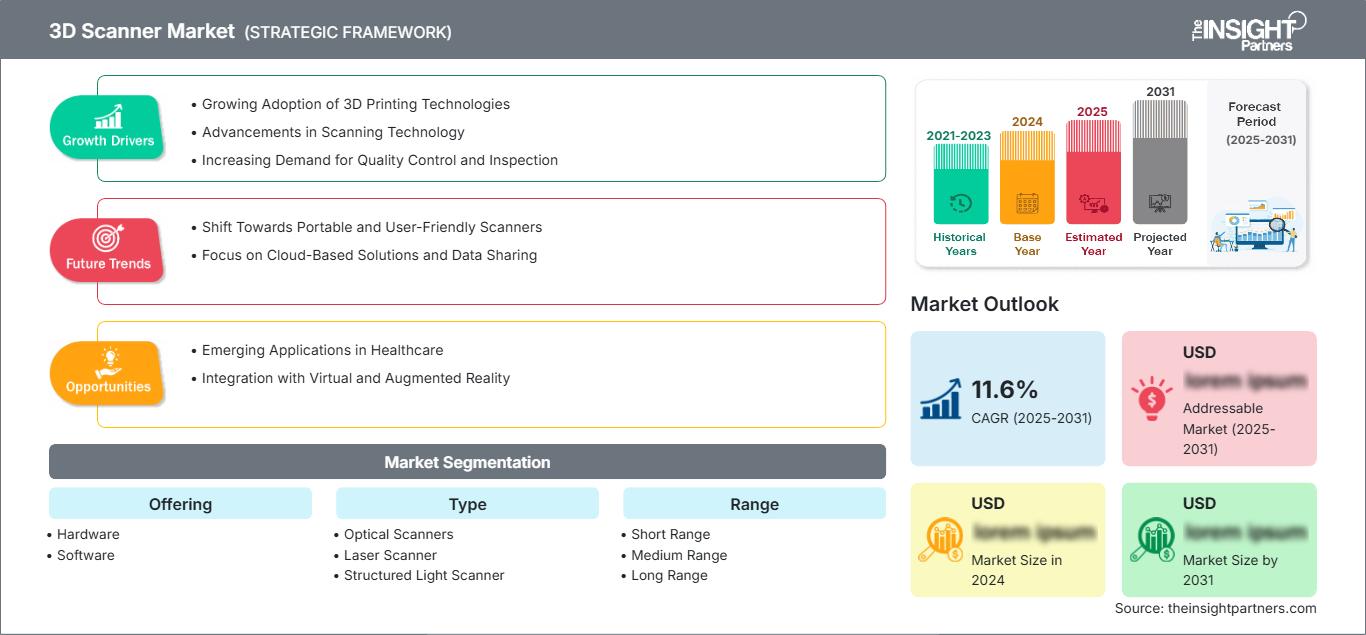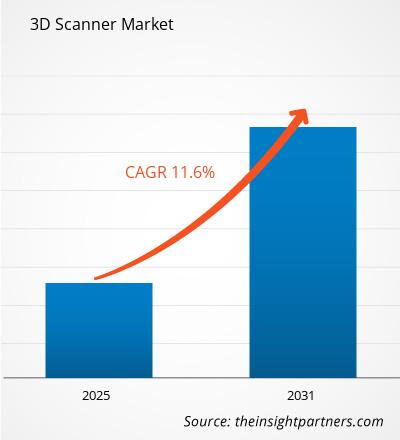Si prevede che il mercato degli scanner 3D registrerà un CAGR dell'11,6% dal 2025 al 2031, con una dimensione del mercato in espansione da XX milioni di dollari nel 2024 a XX milioni di dollari entro il 2031.
Il rapporto è segmentato per Offerta (Hardware, Software); Tipologia (Scanner ottici, Scanner laser, Scanner a luce strutturata); Raggio (Corto raggio, Medio raggio, Lungo raggio); Utente finale (Industriale, Aerospaziale e Difesa, Automotive, Architettura ed edilizia, Sanità, Altri). L'analisi globale è ulteriormente suddivisa a livello regionale e per i principali Paesi. Il rapporto offre il valore in USD per l'analisi e i segmenti sopra indicati.
Scopo del rapporto
Il rapporto 3D Scanner Market di The Insight Partners mira a descrivere il panorama attuale e la crescita futura, i principali fattori trainanti, le sfide e le opportunità. Ciò fornirà spunti a vari stakeholder aziendali, come:
- Fornitori/produttori di tecnologia: per comprendere le dinamiche di mercato in evoluzione e conoscere le potenziali opportunità di crescita, consentendo loro di prendere decisioni strategiche informate.
- Investitori: per condurre un'analisi completa delle tendenze in merito al tasso di crescita del mercato, alle proiezioni finanziarie del mercato e alle opportunità esistenti lungo la catena del valore.
- Organismi di regolamentazione: per regolamentare le politiche e le attività di controllo nel mercato con l'obiettivo di ridurre al minimo gli abusi, preservare la fiducia degli investitori e sostenere l'integrità e la stabilità del mercato.
Offerta di segmentazione del mercato degli scanner 3D
- Hardware
- Software
Tipo
- Scanner ottici
- Scanner laser
- Scanner a luce strutturata
Portata
- Corto raggio
- Medio raggio
- Lungo raggio
Utente finale
- Industriale
- Aerospaziale e difesa
- Automobilistico
- Architettura e costruzioni
- Sanità
- Altri
Potrai personalizzare gratuitamente qualsiasi rapporto, comprese parti di questo rapporto, o analisi a livello di paese, pacchetto dati Excel, oltre a usufruire di grandi offerte e sconti per start-up e università
Mercato degli scanner 3D: Approfondimenti strategici

- Ottieni le principali tendenze chiave del mercato di questo rapporto.Questo campione GRATUITO includerà l'analisi dei dati, che vanno dalle tendenze di mercato alle stime e alle previsioni.
Fattori di crescita del mercato degli scanner 3D
- Crescente adozione delle tecnologie di stampa 3D: l'ascesa della stampa 3D è un fattore determinante per il mercato degli scanner 3D. Con l'adozione crescente della produzione additiva in settori come la produzione manifatturiera, la sanità e l'aerospaziale, cresce la domanda di soluzioni di scansione 3D accurate ed efficienti. Gli scanner 3D consentono una modellazione digitale precisa degli oggetti, essenziale per la creazione di prototipi e componenti di alta qualità. Questa sinergia tra le tecnologie di scansione e stampa 3D aumenta la produttività, accelera lo sviluppo dei prodotti e riduce i costi, favorendo così la crescita complessiva del mercato degli scanner 3D.
- Progressi nella tecnologia di scansione: i continui progressi nelle tecnologie di scansione, come la scansione laser, la scansione a luce strutturata e la fotogrammetria, stanno dando impulso al mercato degli scanner 3D. Queste innovazioni migliorano la precisione, la velocità e la versatilità degli scanner 3D, rendendoli adatti a diverse applicazioni in tutti i settori. Le funzionalità di scansione avanzate consentono di acquisire geometrie complesse e dettagli intricati, fondamentali per settori come l'architettura, l'archeologia e la progettazione di prodotti. L'evoluzione tecnologica offre nuove opportunità per soluzioni di scansione 3D più efficienti ed efficaci, contribuendo all'espansione del mercato.
- Crescente domanda di controllo qualità e ispezione: la necessità di controllo qualità e ispezione nei processi di produzione è un fattore chiave per il mercato degli scanner 3D. Le industrie stanno riconoscendo sempre più l'importanza di misurazioni precise e accuratezza dimensionale per garantire la qualità del prodotto e la conformità agli standard. Gli scanner 3D facilitano l'ispezione e l'analisi in tempo reale, consentendo ai produttori di identificare difetti e incongruenze nelle prime fasi del processo di produzione. Questa capacità riduce gli sprechi, minimizza le rilavorazioni e migliora l'efficienza operativa complessiva, favorendo l'adozione di tecnologie di scansione 3D nelle applicazioni di controllo qualità.
Tendenze future del mercato degli scanner 3D
- Spostamento verso scanner portatili e intuitivi: una tendenza degna di nota nel mercato degli scanner 3D è il passaggio a dispositivi portatili e intuitivi. Con l'aumento della domanda di scansione in loco, i produttori stanno sviluppando scanner leggeri e compatti che possono essere facilmente trasportati e utilizzati dagli utenti con una formazione minima. Queste innovazioni rendono la scansione 3D accessibile a un pubblico più ampio, comprese piccole imprese e singoli professionisti. Questa tendenza migliora la praticità e la flessibilità in varie applicazioni, favorendo la crescita di soluzioni di scansione 3D portatili.
- Focus su soluzioni basate su cloud e condivisione dei dati: la tendenza verso soluzioni basate su cloud sta trasformando il mercato degli scanner 3D. La tecnologia cloud consente agli utenti di archiviare, elaborare e condividere i dati di scansione 3D in modo efficiente. Questo cambiamento facilita i flussi di lavoro collaborativi, consentendo ai team di accedere e analizzare i dati da qualsiasi luogo, migliorando la produttività. Inoltre, le piattaforme basate su cloud integrano spesso analisi avanzate e apprendimento automatico, fornendo informazioni preziose e migliorando i processi decisionali. Con la crescente adozione della trasformazione digitale da parte delle aziende, si prevede una crescita della domanda di soluzioni di scansione 3D basate sul cloud, che guiderà l'innovazione del mercato.
Opportunità di mercato per gli scanner 3D
- Applicazioni emergenti nel settore sanitario: il settore sanitario offre opportunità significative per il mercato degli scanner 3D. Applicazioni come protesi personalizzate, impianti dentali e pianificazione chirurgica richiedono modelli 3D precisi dell'anatomia dei pazienti. Gli scanner 3D possono acquisire impronte dettagliate, consentendo soluzioni personalizzate che migliorano i risultati per i pazienti. Con la continua crescita della domanda di soluzioni sanitarie personalizzate, le aziende possono sviluppare tecnologie di scansione 3D specializzate e su misura per il settore medico, ampliando così la propria portata di mercato e promuovendo l'innovazione nelle applicazioni sanitarie.
- Integrazione con Realtà Virtuale e Aumentata: l'integrazione della scansione 3D con le tecnologie di realtà virtuale (VR) e realtà aumentata (AR) offre nuove opportunità di crescita del mercato. Man mano che i settori esplorano esperienze immersive per la formazione, la progettazione e il marketing, modelli 3D accurati generati dalle scansioni diventano essenziali. Questa sinergia migliora il coinvolgimento degli utenti e fornisce simulazioni realistiche in settori come il gaming, l'istruzione e il settore immobiliare. Le aziende che sviluppano soluzioni che combinano la scansione 3D con le tecnologie VR e AR possono attingere a questo mercato in crescita e soddisfare le esigenze in continua evoluzione di diversi settori.
Approfondimenti regionali sul mercato degli scanner 3D
Le tendenze regionali e i fattori che influenzano il mercato degli scanner 3D durante il periodo di previsione sono stati ampiamente spiegati dagli analisti di The Insight Partners. Questa sezione analizza anche i segmenti e la geografia del mercato degli scanner 3D in Nord America, Europa, Asia-Pacifico, Medio Oriente e Africa, America Meridionale e Centrale.
Ambito del rapporto di mercato degli scanner 3D
| Attributo del rapporto | Dettagli |
|---|---|
| Dimensioni del mercato in 2024 | US$ XX million |
| Dimensioni del mercato per 2031 | US$ XX Million |
| CAGR globale (2025 - 2031) | 11.6% |
| Dati storici | 2021-2023 |
| Periodo di previsione | 2025-2031 |
| Segmenti coperti |
By Offerta
|
| Regioni e paesi coperti | Nord America
|
| Leader di mercato e profili aziendali chiave |
|
Densità degli operatori del mercato degli scanner 3D: comprendere il suo impatto sulle dinamiche aziendali
Il mercato degli scanner 3D è in rapida crescita, trainato dalla crescente domanda degli utenti finali, dovuta a fattori quali l'evoluzione delle preferenze dei consumatori, i progressi tecnologici e una maggiore consapevolezza dei vantaggi del prodotto. Con l'aumento della domanda, le aziende stanno ampliando la propria offerta, innovando per soddisfare le esigenze dei consumatori e sfruttando le tendenze emergenti, alimentando ulteriormente la crescita del mercato.

- Ottieni il Mercato degli scanner 3D Panoramica dei principali attori chiave
Punti di forza
- Copertura completa: il rapporto analizza in modo esaustivo prodotti, servizi, tipologie e utenti finali del mercato degli scanner 3D, offrendo una panoramica olistica.
- Analisi degli esperti: il rapporto è redatto sulla base della conoscenza approfondita di esperti e analisti del settore.
- Informazioni aggiornate: il rapporto garantisce la pertinenza aziendale grazie alla copertura di informazioni e tendenze dei dati recenti.
- Opzioni di personalizzazione: questo rapporto può essere personalizzato per soddisfare le esigenze specifiche del cliente e adattarsi in modo appropriato alle strategie aziendali.
Il rapporto di ricerca sul mercato degli scanner 3D può quindi contribuire a guidare il percorso di decodificazione e comprensione dello scenario del settore e delle prospettive di crescita. Sebbene possano esserci alcune valide preoccupazioni, i vantaggi complessivi di questo rapporto tendono a superare gli svantaggi.
- Analisi storica (2 anni), anno base, previsione (7 anni) con CAGR
- Analisi PEST e SWOT
- Valore/volume delle dimensioni del mercato - Globale, Regionale, Nazionale
- Industria e panorama competitivo
- Set di dati Excel
Report recenti
Rapporti correlati
Testimonianze
Motivo dell'acquisto
- Processo decisionale informato
- Comprensione delle dinamiche di mercato
- Analisi competitiva
- Analisi dei clienti
- Previsioni di mercato
- Mitigazione del rischio
- Pianificazione strategica
- Giustificazione degli investimenti
- Identificazione dei mercati emergenti
- Miglioramento delle strategie di marketing
- Aumento dell'efficienza operativa
- Allineamento alle tendenze normative






















 Ottieni un campione gratuito per - Mercato degli scanner 3D
Ottieni un campione gratuito per - Mercato degli scanner 3D